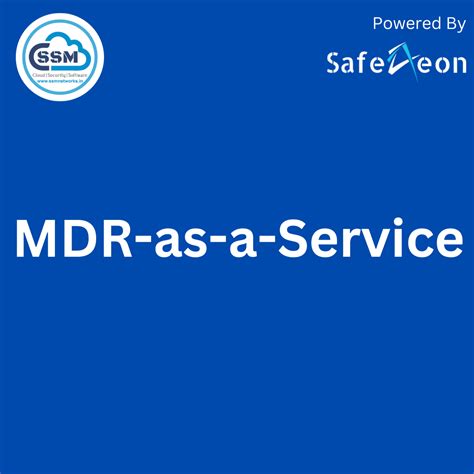MDR as a Service Solution

In today’s cybersecurity landscape, the threat of malware and ransomware attacks is more prevalent than ever. Organizations of all sizes are struggling to keep up with the ever-evolving threat landscape, and the consequences of a successful attack can be devastating. Managed Detection and Response (MDR) as a service has emerged as a highly effective solution to help organizations detect and respond to threats in real-time, reducing the risk of a security breach and minimizing the impact of an attack.
Understanding MDR as a Service
MDR as a service is a proactive approach to cybersecurity that combines technology, expertise, and processes to detect and respond to threats. It involves the use of advanced threat detection tools, such as endpoint detection and response (EDR) and security information and event management (SIEM) systems, to monitor an organization’s network and endpoints for suspicious activity. When a threat is detected, the MDR service provider’s team of expert security analysts will investigate and respond to the incident, working closely with the organization’s IT team to contain and remediate the threat.
Key Benefits of MDR as a Service
The benefits of MDR as a service are numerous. Some of the most significant advantages include:
- Improved Threat Detection: MDR services use advanced threat detection tools and techniques to identify threats that may have evaded traditional security controls.
- Faster Incident Response: MDR services provide 24⁄7 monitoring and incident response, ensuring that threats are detected and responded to in real-time, reducing the risk of a security breach.
- Enhanced Security Expertise: MDR service providers have teams of expert security analysts who can provide guidance and support to help organizations improve their overall security posture.
- Cost Savings: MDR as a service can be more cost-effective than building and maintaining an in-house security operations center (SOC).
- Scalability: MDR services can scale to meet the needs of organizations of all sizes, from small businesses to large enterprises.
How MDR as a Service Works
MDR as a service typically involves the following components:
- Onboarding: The MDR service provider works with the organization to onboard their network and endpoints, installing any necessary detection tools and configuring the service.
- Monitoring: The MDR service provider’s team of expert security analysts monitors the organization’s network and endpoints 24⁄7, using advanced threat detection tools to identify suspicious activity.
- Threat Detection: When a threat is detected, the MDR service provider’s team will investigate the incident, using advanced threat intelligence and analytics to determine the scope and severity of the threat.
- Incident Response: If a threat is confirmed, the MDR service provider’s team will work closely with the organization’s IT team to contain and remediate the threat, providing guidance and support throughout the incident response process.
- Post-Incident Activities: After the incident has been contained and remediated, the MDR service provider’s team will work with the organization to conduct a post-incident review, identifying areas for improvement and providing recommendations for enhancing the organization’s overall security posture.
Selecting an MDR Service Provider
When selecting an MDR service provider, there are several factors to consider. Some of the most important considerations include:
- Security Expertise: Look for a provider with a team of experienced security analysts who have a deep understanding of the threat landscape and the latest detection and response techniques.
- Advanced Threat Detection Tools: Ensure that the provider uses advanced threat detection tools, such as EDR and SIEM systems, to monitor your network and endpoints.
- 24⁄7 Monitoring and Incident Response: Look for a provider that offers 24⁄7 monitoring and incident response, ensuring that threats are detected and responded to in real-time.
- Customizable Services: Consider a provider that offers customizable services, allowing you to tailor the service to meet your organization’s specific security needs.
- Cost-Effective Pricing: Look for a provider that offers cost-effective pricing, with flexible pricing models that can scale to meet your organization’s needs.
Real-World Example
A mid-sized healthcare organization was struggling to keep up with the ever-evolving threat landscape. They had experienced several security incidents in the past, including a ransomware attack that had resulted in significant downtime and data loss. The organization decided to implement an MDR as a service solution, which included 24⁄7 monitoring and incident response, as well as advanced threat detection tools. Since implementing the service, the organization has seen a significant reduction in security incidents, and has been able to improve its overall security posture.
Conclusion
MDR as a service is a highly effective solution for organizations looking to improve their threat detection and incident response capabilities. By combining advanced threat detection tools with expert security analysts and 24⁄7 monitoring and incident response, MDR services can help organizations detect and respond to threats in real-time, reducing the risk of a security breach and minimizing the impact of an attack. When selecting an MDR service provider, consider factors such as security expertise, advanced threat detection tools, and customizable services, and look for a provider that offers cost-effective pricing and a proven track record of detecting and responding to threats.
What is MDR as a service?
+MDR as a service is a proactive approach to cybersecurity that combines technology, expertise, and processes to detect and respond to threats.
What are the benefits of MDR as a service?
+The benefits of MDR as a service include improved threat detection, faster incident response, enhanced security expertise, cost savings, and scalability.
How does MDR as a service work?
+MDR as a service typically involves onboarding, monitoring, threat detection, incident response, and post-incident activities.



